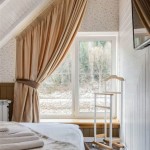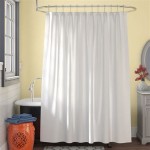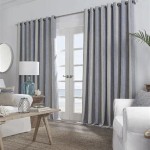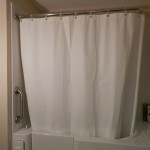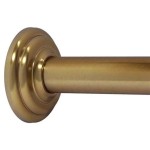What Is A Valance For Curtains?
A valance, in the context of window treatments, is a decorative piece of fabric that is installed across the top of a window. Its primary purpose is to conceal curtain hardware like rods, tracks, or the headrails of blinds and shades. Beyond functionality, valances serve as an aesthetic element, adding style, color, and visual interest to a room. They come in a wide array of styles, fabrics, and designs, allowing for customization to complement various décor themes.
The term "valance" is often used interchangeably with other window treatment terms like "cornice" and "pelmet." While there are similarities, subtle differences exist. A valance is typically made of fabric, soft and flowing, while a cornice is usually a hard, structured frame, often made of wood or a similar rigid material. Pelmets can be either hard or soft, and often wrap around the sides of the window, unlike a valance, which typically only covers the top. Understanding these distinctions allows for more informed decisions when selecting window treatments.
The history of valances can be traced back centuries, evolving alongside advancements in textile production and interior design trends. Initially, they were primarily functional, used to block drafts and conceal less aesthetically pleasing curtain mechanisms. Over time, they transformed into elaborate decorative elements, reflecting the prevailing styles of different eras. From the ornate valances of Victorian interiors to the streamlined designs of mid-century modern homes, the evolution of the valance mirrors the evolution of decorative arts.
Key Functions of a Valance
The primary function of a valance is to conceal curtain hardware. Exposed curtain rods, pleats, or the mechanisms of blinds and shades can detract from the overall aesthetic of a room. A valance neatly hides these elements, creating a cleaner and more polished look. This is particularly beneficial when using basic or utilitarian curtain hardware.
Beyond concealment, valances offer insulation benefits. By covering the top of the window, they help to minimize drafts and prevent heat loss during colder months. This insulation, while not as significant as specialized thermal curtains, contributes to energy efficiency and can help to reduce heating costs. The effect is more pronounced with heavier fabrics and layered valance styles.
A valance can also alter the perceived proportions of a window or room. A valance installed higher than the actual window frame can create the illusion of a taller window, making the room feel more spacious. Conversely, placing a valance lower can create a sense of coziness. The color and pattern of the valance can also play a role in shaping the visual impression of the space.
Types of Valances
Numerous styles of valances are available, each offering a distinct aesthetic and functional advantage. The choice depends on the overall design theme of the room and the desired effect. Some popular types include: gathered valances, pleated valances, shaped valances, and tailored valances.
Gathered valances are characterized by their soft, flowing appearance, typically created by gathering the fabric along a rod or heading tape. They offer a casual and romantic feel, suitable for bedrooms, living rooms, or kitchens with a relaxed aesthetic. The level of fullness can be adjusted to create varying degrees of draping.
Pleated valances feature structured folds that create a more formal and tailored look. Common pleat styles include box pleats, inverted pleats, and kick pleats. These valances are well-suited for more traditional or sophisticated interiors, adding a touch of elegance to living rooms, dining rooms, or formal bedrooms.
Shaped valances, also known as arched or scalloped valances, feature a curved or decorative bottom edge. These valances add a unique visual element to a window, softening the lines and adding a touch of whimsy. They are often used in bedrooms, nurseries, or bathrooms to create a more playful or personalized aesthetic.
Tailored valances offer a clean, minimalist look, often made from flat panels of fabric. They are ideal for modern or contemporary interiors, providing a sleek and understated window treatment solution. The edges can be finished with piping or banding for added detail.
Choosing the Right Fabric for a Valance
The choice of fabric significantly impacts the look and feel of a valance. Different fabrics offer varying levels of drape, texture, and light control. Considerations should include the desired aesthetic, the function of the room, and the level of maintenance required.
For a soft and flowing look, lightweight fabrics like cotton, linen, or voile are suitable choices. These fabrics allow natural light to filter through, creating a bright and airy atmosphere. They are also relatively easy to care for, making them a practical option for everyday use.
For a more structured and formal look, heavier fabrics like velvet, brocade, or damask are preferred. These fabrics offer a richer texture and a more luxurious appearance. They are more resistant to wrinkles and can provide better insulation, but may require professional cleaning.
Patterned fabrics can add visual interest and personality to a valance. Options range from subtle textures to bold prints. When choosing a patterned fabric, consider the scale of the pattern in relation to the size of the window and the overall décor of the room. Coordinate or contrast with existing colors and patterns to create a cohesive look.
Durability and maintenance are important considerations when selecting fabric. Fabrics that are resistant to fading, stains, and wrinkles are ideal for high-traffic areas or for those who prefer low-maintenance window treatments. Consider the cleaning instructions for each fabric before making a selection.
Installation and Measurement of a Valance
Proper installation is crucial for achieving the desired look and functionality of a valance. Accurate measurements are essential for ensuring a perfect fit. Whether installing a pre-made valance or creating a custom design, careful planning is necessary.
Begin by measuring the width of the window, including any trim or casing. Add extra width to the measurement to allow for sufficient coverage and to create a more balanced appearance. The amount of extra width depends on the desired style and the amount of fullness.
Determine the desired length of the valance. Consider the height of the window, the height of the ceiling, and the overall proportions of the room. A general guideline is to choose a length that is approximately one-fifth to one-third of the window's height. A longer valance can create a more dramatic effect, while a shorter valance offers a more subtle look.
Installation methods vary depending on the type of valance and the type of hardware used. Common methods include using a curtain rod, a decorative rod pocket, or a mounting board. Follow the manufacturer's instructions carefully for proper installation. Ensure that the hardware is securely mounted to the wall or window frame.
Valances in Interior Design
Valances are versatile elements in interior design, capable of complementing a wide range of styles. They can be used to add a touch of formality to a traditional room, to soften the lines of a modern space, or to introduce color and pattern to a neutral setting.
In traditional interiors, valances are often paired with heavy drapes and ornate hardware. Fabrics like velvet, brocade, and damask are common choices, often embellished with tassels, fringe, or decorative trim. These valances create a rich and luxurious atmosphere, evoking a sense of timeless elegance.
In modern interiors, valances tend to be simpler and more streamlined. Tailored valances or minimalist designs in neutral colors are often preferred. The focus is on clean lines and understated elegance, complementing the overall aesthetic of the space.
Valances can also be used to introduce color and pattern to a room. A brightly colored or patterned valance can serve as a focal point, adding visual interest to a neutral space. Coordinate the colors and patterns with other elements in the room, such as throw pillows, rugs, or artwork, to create a cohesive look.
The use of valances extends beyond residential settings. They are often incorporated into commercial spaces, such as hotels, restaurants, and offices, to enhance the ambiance and create a more polished and professional environment. The choice of style and fabric often reflects the brand identity and the overall design concept.

Cornice Vs Valance What S The Difference Shade

What Is The Difference Between A Cornice And Valance Blindsgalore Blog

Cornice Vs Valance What S The Difference Shade

Curtain Pelmet Vs Valance Frinton Frames

Rlf Home Pashmina Petticoat 50 Curtain Valance Color Black

What Is The Difference Between A Valance And Swag

How To Hang Curtains With Valance Spiffy Spools

Create Kids Couture How To Sew A Valance Or Curtain

Mainstays Textured Solid Curtain Single Panel 56 X 17 Gray

Windsor Layered Curtain Valance

